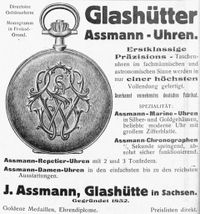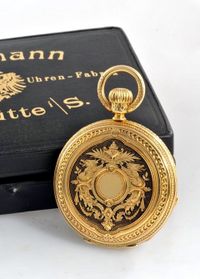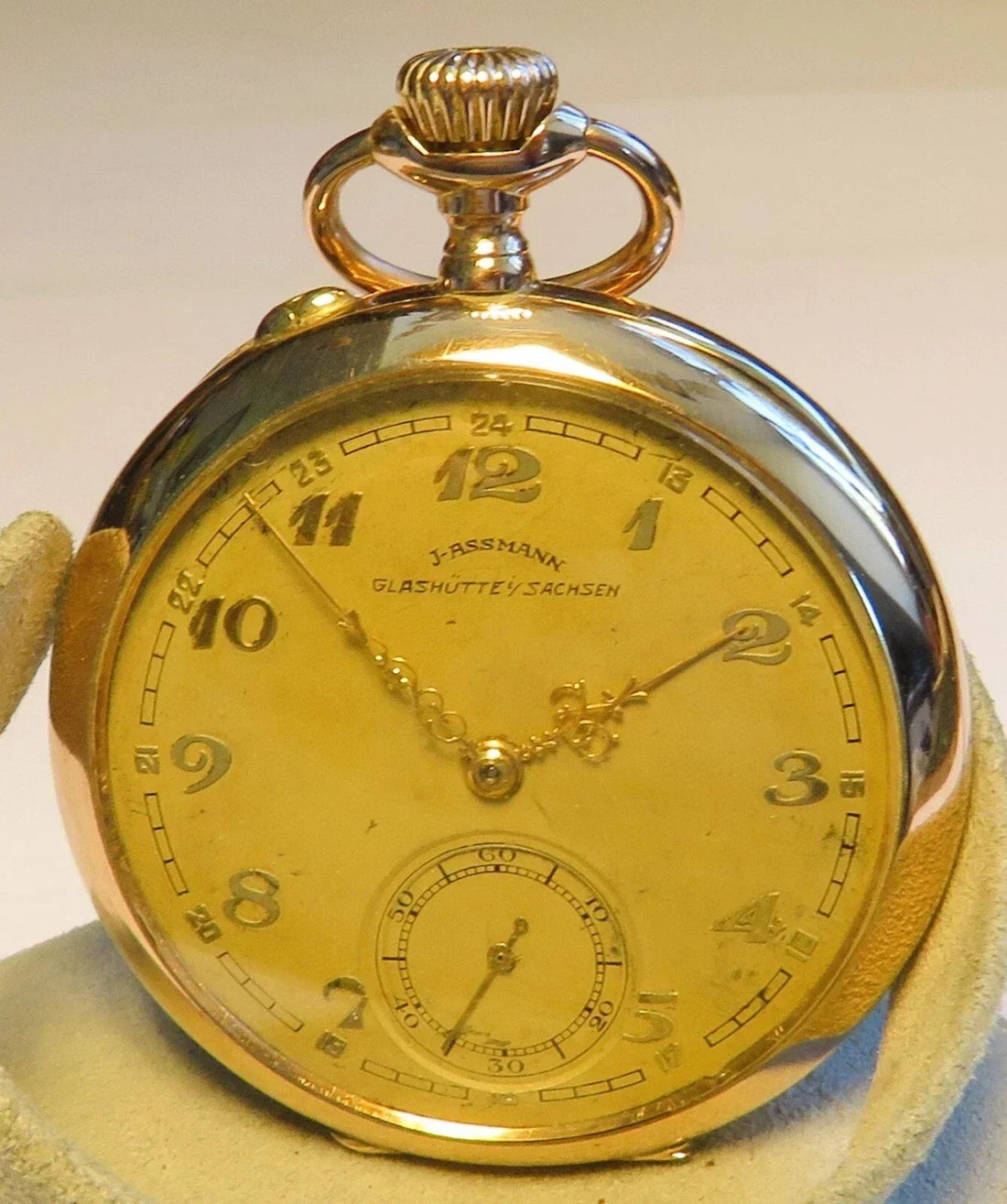
Julius Assmann Glashütte near Dresden Age determination according to movement numbers and characteristics
Share
J. Assmann/Glashütte i.SA, German Anchor Watch Factory
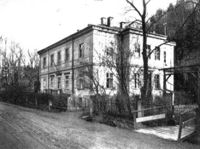
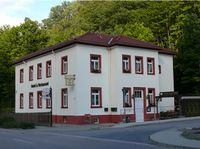
In 1852, Julius Assmann founded this watch factory in Glashütte on the advice of FA Lange . His son from his first marriage, Paul, joined the company as a co-owner in 1877 and, after his father 's death in 1886, managed it independently.
The German Ankeruhren-Fabrik of J.Assmann produced high-quality Pocket watches with all the features typical of Glashütte pocket watches of the time. These include the three-quarter plate , the Glashütte gold lever escapement, and the index spring fine adjustment.
In terms of design and quality, Assmann pocket watches are completely equivalent to those from A. Lange & Söhne , but they are much rarer. Assmann contributed his own designs and ideas to production, such as the "Fortschritt" movement type with a split three-quarter plate and the Glashütte balance lever modeled on the Swiss Moustache lever . He frequently used this lever design in steel instead of hammered gold, along with a steel escape wheel.
When the market demanded more affordable watches, Assmann responded differently than Lange & Söhne, which launched the more affordable DUF brand. Assmann didn't develop a cheaper movement himself, but imported Swiss cock movements "Lecoultre Cal. 6," which he then refined.
These Swiss cock movements can also be found in the same or very similar form in pocket watches from the " Union Horlogere ." Assmann was a member of this originally Swiss association of watch manufacturers until 1904 and sold Assmann watches with the dial inscription "Union Horlogere J. Assmann Glashütte/Sa." When the Union Horlogere prepared to set up its own production facility in Glashütte, Assmann left the association.
In contrast to the usual practice at Lange & Söhne for the ALS and DUF watches, Assmann often failed to mark movements and cases with the same number. This isn't a quality defect, but it does make it difficult to distinguish authentic watches from those later assembled differently, especially since no documents, such as shipping records, have survived.
The inscriptions and hallmarks on the movement and case are therefore crucial for determining genuineness and authenticity. From 1893 to 1897 , Assmann manufactured, among other things, pocket watch movements for the company D. Gruen & Son , Cincinnati. Frederick Gruen , who worked for Assmann for a time after his training at the German Watchmaking School in Glashütte , was responsible for this production. In 1897, Georg Heinrich became a partner in the J. Assmann company, which he took over completely after the death of Paul Assmann in 1911 .
In 1910/11 the company took part in chronometer tests .
On June 1, 1917, G. Heinrich and the J. Assmann company joined the Thüringer Uhrenfabrik Edmund Herrmann AG stock corporation. However, the company ran into financial difficulties around 1925 and was liquidated. In 1926, Fritz J. Assmann founded J. Assmann GmbH with the participation of Walter Theden .
A storm destroyed the company's production building in 1927. This devastating blow forced Fritz J. Assmann to permanently close the company in 1930. After A. Lange & Söhne, Assmann was one of the most well-known Glashütte companies, producing excellent pocket watches of all quality levels and degrees of complication.
By 1931, a total of 40,000 pocket watches had been produced, including approximately 8,000 movements for D. Gruen & Son. On the antique watch market, Assmann watches are equivalent to those of A. Lange & Söhne, but do not quite reach their prices.
Description with movement number and year of manufacture of well-known Julius Assmann pocket watches from "Glashütte Uhren":
The movement number 1533 is the earliest documented pocket watch from the J. Assmann company . This watch was manufactured around 1857.
From around 1861, key-winding pocket watches were manufactured with the Glashütte gold anchor escapement. In the following years, up until around 1865, the crown winding mechanism and the three-quarter plate were also used.
A gold savonette pocket watch with the movement number 2527, one of the earliest known pocket watches from the J. Assmann company. This 1st-quality, 20-jewel crown-winding watch was still fitted with a 2/3 plate and separate escapement wheel cock, presumably around 1860.
Open pocket watch by Julius Assmann No. 2724 from around 1862
Pocket watch movement number 2888, built before 1965
15-jewel Savonette pocket watch by J. Assmann with case number 6847, made around 1880
16-jewel TU custom-made in 900 silver case with movement number 7280 made around 1882
Savonette pocket watch with the movement and case number 8443 was manufactured around the year 1879
Early pocket watch has the movement and case number 8507. The year 1904 engraved on the cuvette does not correspond to the current production time of the watch, which can be dated to 1880
Very well preserved savonette pocket watch with the number 8536 was manufactured around 1880 by the company J. Assmann
TU with movement and case number 9649, it was encased in a gold case with a fineness of 750/1000. Estimated year of manufacture: 1886
Savonette pocket watch with identical movement and case number 10074 was manufactured around 1889
Rare TU minute repeater, manufactured as a half-savonette around 1890. Movement and case number is 10328
Open pocket watch with the identical movement and case number 11692, was manufactured around 1895
According to current knowledge, the gold precision pocket watch was probably completedaround 1896 , movement number 11912
Pocket watch movement number 14436, year of manufacture 1903
pocket watch movement number 14637, year of manufacture 1903
Gold pocket watch movement number 16047, year of manufacture 1904
Pocket watch movement number 18764 - year of manufacture 1910
Pocket watch movement number 20014, year of manufacture 1911
Marine observation clock 23371, built around 1922
Pocket watch movement number 23989, built around 1924
Compare dial & signature
-
Classic: “J. Assmann Glashütte i. Sa.” = original, mostly 1880–1914
-
“Julius Assmann Dresden” = early pieces ca. 1850–1875
-
“Assmann Glashütte German Anchor Watch Factory” = from around 1880
-
Late re-foundation (1926–1930) often had simpler lettering
Typical age classification
-
approx. 1852–1886 (founding period until the death of Julius Assmann)
-
Clockworks with pin anchor, key winding, later pendant anchor and lever.
-
Precision pocket watches with gold cases and Glashütte quality
-
-
approx. 1886–1914 (Paul Assmann / Georg Heinrich)
-
Further development in complications (e.g. perpetual calendar, moon phase).
-
High-quality models with gold chatons, diamond endstone, manual winding, three-quarter plate
-
-
1926–1930 (New beginning under Julius Fritz Assmann)
-
Small quantities, about 28,000 watches produced in total.
-
Works from the late 1920s with typical gold gilding
-
How to determine your year of construction
-
Movement type & movement number
-
Hand-wound with lever/three-quarter plate → around 1900.
-
Complication such as perpetual calendar/moon phase → mostly ca. 1890–1910.
-
New production 1926–1930: late works with gold gilding, Swiss ruby setting
-
-
Housing & Materials
-
18 K/14 K gold case, savonnette style → late 1800s to early 1900s.
-
Engraved gold lids, gold chatons → particularly elaborate watches from the heyday.
-
-
Signature inscription
-
“J. Assmann Glashütte i. Sa.” → until 1914.
-
“Julius Assmann” + later addition → 1926–1930
-
Age assessment table
| feature | epoch |
|---|---|
| Pin anchor + key winding | 1852–1880 |
| Lever movement with three-quarter plate + manual winding | 1880–1914 |
| Perpetual calendar, moon phase complication | 1890–1914 |
| Late series of the 1926 re-foundation | 1926–1930 |
Example numbers and estimated years of manufacture:
| Serial number | Estimated year of construction |
|---|---|
| < 5,000 | approx. 1855–1875 |
| 5,000 – 15,000 | approx. 1875–1890 |
| 15,000 – 25,000 | c. 1890–1905 |
| 25,000 – 30,000 | approx. 1905–1914 |
| > 30,000 | approx. 1926–1930 (refoundation) |
Source: WatchWiki, "Glashütte Watches", AI, Gemini

